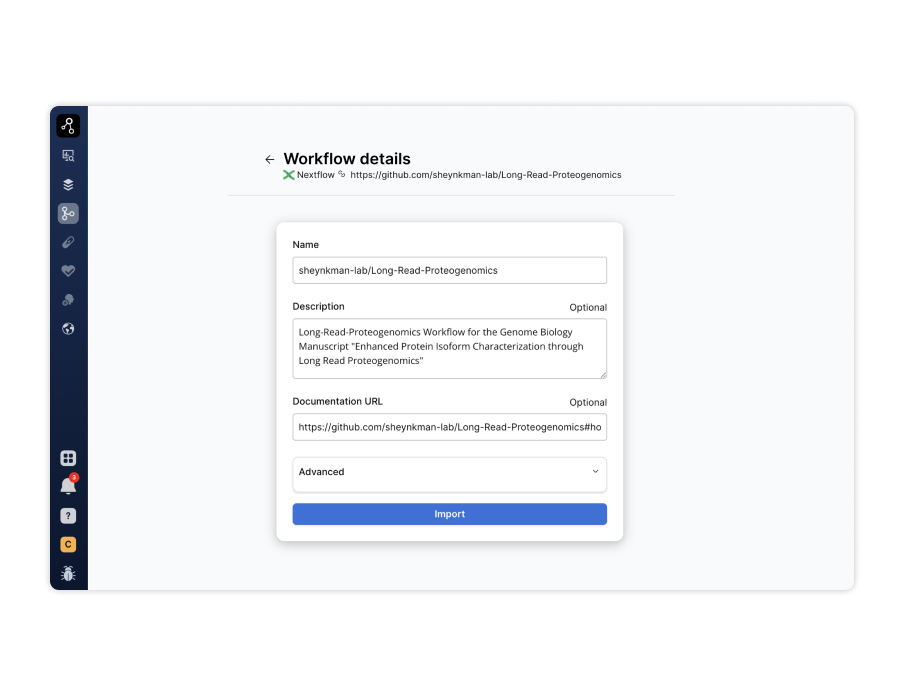NF-Copilot™
Scale & automate Nextflow-based workflows
Manage, monitor and scale bioinformatics pipelines with Lifebit’s NF-Copilot™ – the industry-leading solution for streamlined data engineering workflows in life sciences.
NF-Copilot™ Free
NF-Copilot™

What is NF-Copilot™?
NF-Copilot™ is the ultimate tool for managing Nextflow-based pipelines, offering bioinformaticians across sectors a centralized interface to manage, monitor, and scale workflows seamlessly.
From pipeline import and catalog management to advanced monitoring and automated resource optimization, NF-Copilot™ eliminates complexity, enabling teams to focus on life-saving research. With a free, collaborative version now available, NF-Copilot™ is accessible to organizations of any size.

Enterprise-grade workflow management at the lowest costs
Run and scale Nextflow-based pipelines effortlessly with robust, self-serve functionality and enterprise-level controls in your own cloud or on premise environment. Lifebit achieves the lowest costs of ownership on the market.
Unmatched security and compliance
Protect sensitive data with full compliance (FedRAMP, GDPR, HIPAA, ISO, and SOC II) and advanced security. Lifebit is trusted by governments, pharma companies and major research organizations using federated architecture to ensure data residency and adherence to data privacy regulations.
Simplified collaboration and monitoring
Streamline teamwork with an intuitive interface, advanced monitoring tools, and seamless data auditability for reproducibility. Lifebit is the only platform offering free Nextflow-based pipeline collaboration without user limits.
Why Lifebit?
Your trusted partner for seamless, secure, and scalable workflow management
Impact
Accelerate bioinformatics research and streamline workflow management with Lifebit’s NF-Copilot™
SAVE COSTS
Up to 90%
Less cloud cost through cost-saving instances with automated resource termination.
FASTER WORKFLOWS
80%
reduction in time spent managing and executing pipelines.
ENHANCED REPRODUCTIBILITY
100%
Simple cloning and auditability of analysis inputs, outputs, and metadata.
Plans to suit your needs
Free

Perfect for small teams
- Fully free with no hidden costs for unlimited users
- Pipeline import and catalog management
- Automated resource termination post-analysis
- Advanced monitoring for streamlined troubleshooting
- Unified interface for configuring workflow execution templates for end users
- Use your own AWS, GCP, Azure cloud or HPC cluster
Enterprise
For organizations needing full enterprise settings
- Multiple workspaces for secure data management
- Complete cost management
- Organization-level workflow management
- Access to Lifebit’s Security Operations Centre
- Dedicated support and enterprise SLAs
- Advanced user onboarding and offboarding
- Advanced SSO configuration
- Integration with Active Directory & LDAP

How it works
1. Import pipelines
Bring your own pipelines and create your own Nextflow-based workflows for seamless organization

2. Configure parameter templates
Set up user-friendly execution templates tailored to end users’ needs.

3. Run workflows
Execute workflows effortlessly with fully-automated resource allocation and management across cloud and HCP.

4. Monitor and optimize
Leverage detailed logging and analytics to streamline troubleshooting and ensure time and cost efficient runs.

5. Collaborate and scale
Collaborate with teams in a unified environment and scale effortlessly as needs grow.

Collaborative and secure research, discovery and translation
Featured news and events
Ready to collaborate on distributed data?
Contact Lifebit today and discover how our federated data solutions can accelerate your research.
We’ll respond as soon as possible.
Lifebit will only use your personal information to provide information about our products and services. From time to time we may email you, which you may unsubscribe from at any time. To learn more, see our Privacy Policy and Cookie Policy.












